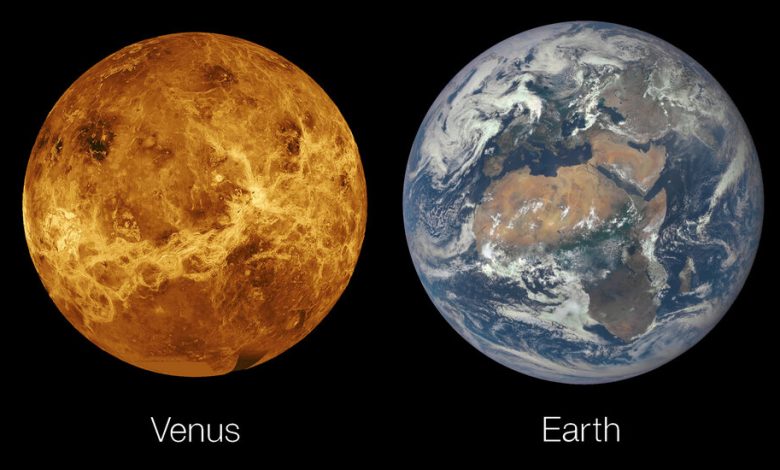Billions of Years Ago, Venus May Have Had a Key Earthlike Feature

Venus today is not like Earth. Temperatures hover around 860 degrees Fahrenheit day and night, and clouds of sulfuric acid float in its atmosphere.
But a study published Thursday in the journal Nature Astronomy suggests that Venus in its youth may have possessed a key Earth-like trait: plate tectonics, the continual reshaping of pieces of the planet’s outer crust.
“One of the takeaways from this study is that both planets very likely had plate tectonics operating roughly at the same period of time,” said Matthew B. Weller, a planetary scientist at the Lunar and Planetary Institute in Houston who led the research.
If true, that suggests Venus could have been much more like Earth in other ways. The geochemical reactions of plate tectonics could have buried much of the carbon dioxide that makes Venus so hellish today.
That adds fodder to the notion that a few billion years ago, Venus may have been a place where life could have thrived.
“That’s a very likely scenario,” Dr. Weller said. “It does suggest that certainly Venus would have been cooler and then there would have been more liquid water.”
Dr. Weller and his colleagues at Brown University and Purdue University did not spot any San Andreas fault-like fractures or other telltale visual signs of plate tectonics. Rather, they looked at the air — nitrogen, in particular.
When rocky planets like Earth and Venus form, nitrogen is locked in minerals. But in volcanic eruptions, the minerals melt and chemical bonds break, and then nitrogen can escape into the atmosphere, where it tends to stay.
“So nitrogen really becomes this kind of diagnostic tool” for understanding a planet’s tectonic history, Dr. Weller said.
Then the scientists set up computer simulations exploring two types of tectonic models. One was what is called the stagnant lid, which describes worlds like Mars and the Earth’s moon where the outer crust consists of a solid shell, unmoving. Most of the gases remain trapped beneath the outer crust lid.
The second model was plate tectonics. On Earth, about 80 percent of volcanism occurs along mid-oceanic ridges where two tectonic plates are spreading apart and magma upwells. That releases much more gas into the atmosphere.
If Venus had always possessed a stagnant lid crust, as it appears to have now, the simulations indicated there would be less nitrogen than what is observed today — 3.5 percent of the atmosphere.
The explanation that worked was a combination of the two models: an early phase of plate tectonics that released bountiful carbon dioxide and nitrogen, followed by the crust locking up into a stagnant lid.
Scientists not involved with the research said the findings were suggestive but not conclusive.
Cédric Gillmann, a planetary scientist at the Swiss Federal Institute of Technology who was not involved with the research, said the paper was interesting but cautioned that “as with all model-based publications, these are very dependent on what is included and what is omitted.”
Joseph O’Rourke, a professor of earth and space exploration at Arizona State University, said that perhaps the geological history of Venus did not fit neatly with either Earth-like plate tectonics or a Mars-like stagnant lid.
“Perhaps Venus is its own thing that is intermediate between Earth and Mars,” he said.
One proposed alternative explanation is called the plutonic squishy lid model — magma intrudes the outer crust, or lithosphere, without breaking it apart into tectonic plates. That could explain circular features called coronae on the surface of Venus, pushed upward by plumes of hot material rising from the mantle.
“The lithosphere is more ooey gooey and features localized breakage,” Dr. O’Rourke said.
Dr. Weller said that in the plutonic squishy lid model, most of the magma never reaches the surface and thus would most likely not release gushes of nitrogen.
Spacecraft headed to Venus in the coming years should provide crucial new data to help resolve the mysteries. Dr. O’Rourke noted that he had just been born when Magellan, NASA’s last mission there, entered orbit in 1990. “I was like 10 days old,” he said. “So I’m stoked to actually see some new Venus missions in my lifetime.”
NASA’s Davinci spacecraft, tentatively scheduled to launch in 2029, will use a parachuting probe to make precise measurements of the gases in the atmosphere, providing clues to present-day volcanism.
Another anticipated NASA mission, Veritas, will make detailed measurements of the planet’s gravity and take high-resolution images of the surface.
“That will really help us look for potential plate boundaries,” said Anna Gülcher, a planetary scientist at the California Institute of Technology and NASA’s Jet Propulsion Laboratory.
The European Space Agency is also planning to launch a robotic mission, EnVision, to help scientists understand why conditions on Earth and Venus diverged so much.
Dr. Weller’s computer models could also help shed light on the geological history of planets around other stars by studying what is detected in the air around them.
“That was the original idea for the work,” Dr. Weller said, “and it quickly migrated to being able to explain something about Venus.”





